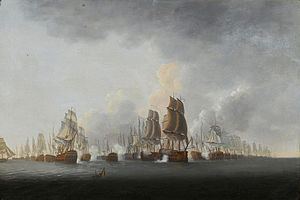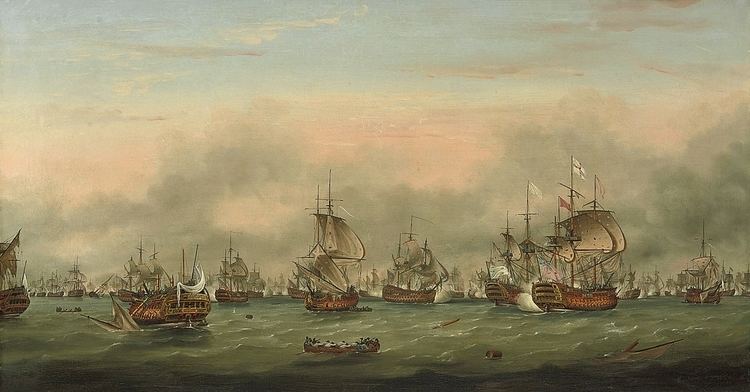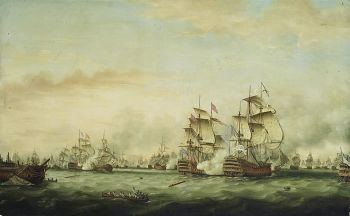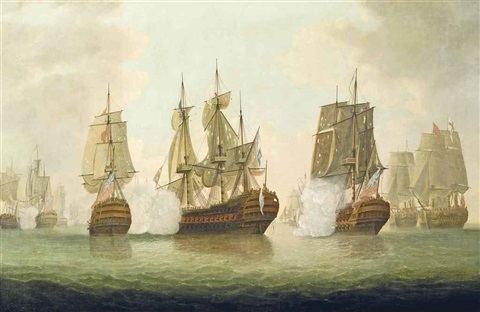36 ships of the line 33 ships of the line Result Decisive British victory | Dates 9 Apr 1782 – 12 Apr 1782 | |
 | ||
243 dead,816 wounded 4 ships of the line captured,1 destroyed3,000 dead or wounded,5,000 captured Similar American Revolutionary War, Battle of the Chesapeake, Battle of Ushant, Battle of Saint Kitts, Battle of Martinique | ||
Royal navy s revenge the battle of the saintes
The Battle of the Saintes (known to the French as the Bataille de la Dominique), or Battle of Dominica was an important naval battle that took place over four days, 9 April 1782 – 12 April 1782, during the American Revolutionary War, and was a victory of a British fleet under Admiral Sir George Rodney over a French fleet under the Comte de Grasse, forcing the French and Spanish to abandon a planned invasion of Jamaica.
Contents
- Royal navy s revenge the battle of the saintes
- Battle of the saintes british crush france 1782
- Origins
- Battle
- Breaking of the line
- Aftermath
- References

The battle is named after the Saintes (or Saints), a group of islands between Guadeloupe and Dominica in the West Indies. The French fleet defeated here by the Royal Navy was the fleet that had blockaded the British Army during the Siege of Yorktown. The French suffered heavy casualties and many were taken prisoner, including the Comte de Grasse. Four French ships of the line were captured (including the flagship) and one was destroyed. Rodney was credited with pioneering the tactic of "breaking the line" in the battle, though this is disputed.

Had a chief worthy Britain commanded our fleet,
Twenty-five good French ships had been laid at our feet.
Battle of the saintes british crush france 1782
Origins

In October 1781, a plan had been worked out between Admiral Comte de Grasse, commander of the French fleet in the West Indies, and Francisco Saavedra de Sangronis, General Bureau for the Spanish Indies, court representative and aide to the Spanish Governor of Louisiana, Bernardo de Gálvez. The strategic objectives of the Franco-Spanish military forces in the West Indies in this plan were:


This plan became known as the "De Grasse – Saavedra Convention", and the first objective was essentially met with the surrender of the British army under General Cornwallis at the Siege of Yorktown in September 1781. De Grasse and his fleet played a decisive part in that victory, after which they sailed to the Caribbean. On arrival in Saint Domingue in November 1781, he was notified that the plan was given the go ahead to proceed with the conquest of Jamaica.

Jamaica was the largest and most profitable British island in the Caribbean, mainly because of sugar; it was more valuable to the British economy than the thirteen American colonies. In a letter from King George III to Lord Sandwich, he declared that he would risk protecting Britain's important Caribbean islands at the risk of Britain herself, and this was the strategy implemented in 1779. Sugar made up 20% of all British imports and was worth five times as much as tobacco. As well as the gradual expulsion of the British from the West Indies by the French and Spanish, the conquest was to inflict a massive blow on the British economy. The invasion itself though was perceived in the courts at Paris and Madrid as an alternative to the Spanish and French attempts to take Gibraltar, which for two years had been a costly disaster.
While de Grasse waited for reinforcements to undertake the Jamaica campaign, he captured St. Kitts in February 1782. The rest of the Windward Islands - Antigua, St Lucia, and Barbados - still remained under British control, while Admiral George Rodney arrived in the Caribbean theatre the following month, bringing reinforcements. These included seventeen ships of the line and gave the British a slight numerical advantage.
On 7 April 1782, de Grasse set out from Martinique with 35 ships of the line, including two 50-gun ships and a large convoy of more than 100 cargo ships, to meet with a Spanish fleet of 12 ships of the line. In addition, de Grasse was to rendezvous with 15,000 troops at Saint Domingue earmarked for the conquest by landing on Jamaica's north coast. Rodney, on learning of this, sailed from St Lucia in pursuit with 36 ships of the line the following day.
The British hulls by this time had been given copper sheathing to protect them from marine growth and fouling as well as salt water corrosion. This dramatically improved speed and sailing performance as a whole in good wind.
Battle
On 9 April 1782, the copper-hulled British fleet soon caught up with the French, who were surprised by their speed. De Grasse ordered the French convoy to head into Guadeloupe for repair, forcing him to escort two fifty-gun ships (Fier and Experiment) and placing his fleet in line of battle in order to cover the retreat. The British fleet became separated from the centre and rear divisions and eight ships of their vanguard under Rear-Admiral Samuel Hood, however, moved against de Grasse's retreating ships and waged a fight. After an inconclusive encounter in which both sides suffered damage, de Grasse soon realized that the main British fleet would soon be upon them. He broke off the engagement to return to protect the merchant convoy.
In the following days the two fleets faced each other parallel but both sides kept their distance as they repaired their ships.
On 12 April, the French were sighted a short distance away, as the two fleets maneuvered between the northern end of Dominica and the Saintes. A French straggler, Zélé (74 guns), was spotted and was chased by four British ships as De Grasse made for Guadeloupe. He bore up with his fleet to protect the ship which led him to Guadeloupe and at the same time Rodney recalled his chasing ships and made the signal for line of battle.
Rear-Admiral Hood's van division were still making repairs from the action three days earlier, so he directed his rear division, under Rear Admiral Francis S. Drake, to take the lead. At 7:40, HMS Marlborough, under Captain Taylor Penny, led the British line and opened the battle when he approached the center of the French line. Having remained parallel with the French, the ships of Drake's division then passed the remaining length of de Grasse's line and the two sides exchanged broadsides, a typical naval engagement of this time.
Breaking of the line
As the battle progressed, the strong winds of the previous day and night began to temper and became more variable. As the French line passed down the British line, the sudden shift of wind let Rodney's flagship HMS Formidable and several other ships, including HMS Duke and HMS Bedford, sail towards the French line.
At 8 am, Formidable opened fire and engaged the French center and as she slowed, duelled with de Grasse's flagship, Ville de Paris of 104 guns. The rest of the ships soon followed, raking the French as they did so, causing huge casualties amongst the soldiers and sailors. Around 9 am, Drake's rearmost ship, HMS Russell, cleared the end of the French fleet and hauled wind; while his ships had taken some damage, they had inflicted a severe battering on them.
Within an hour, the wind had shifted to the south and thus forced the French line to separate and bear to the west, as it could not hold its course into the wind. This allowed the British to use their guns on both sides of their ships without any fear of return fire from the front and rear of the French ships they were passing between. The effect was greater with the use of carronades, with which the British had just equipped nearly half their fleet; this relatively new short-range weapon was quicker to reload and more could be carried. Glorieux was the first victim; virtually a sitting duck, she was quickly pounded and dismasted by intense fire. Four French ships in the confusion began milling around; Formidable turned to starboard and brought her port guns to bear on them. As a result, Formidable sailed through the French line, blasting her way through; this piercing was followed by five other British ships.
At the same time, Commodore Edmund Affleck, to the south, also immediately capitalized on the opportunity and led the rearmost of the British ships through the French line, inflicting significant damage. The French tried to restore order; around 1:30 pm, De Grasse signaled line on the port tack, but this was not fulfilled; he was soon battling Hood's 90-gun HMS Barfleur. With their formation shattered and many of their ships severely damaged, the French fell away to the southwest in small groups. Rodney attempted to redeploy and make repairs before pursuing the French. By 2 pm, the wind had freshened and a general chase ensued. As the British pressed south, they took possession of Glorieux and caught up with the French rear at around 3 pm. In succession, Rodney's ships isolated the other three ships. César which was soon totally dismasted and in flames, was captured by HMS Centaur. Hector, a complete dismasted wreck, struck after having battled HMS Canada and HMS Alcide. Ardent soon followed, being taken by the rest of the British centre.
At 4 pm, de Grasse with Ville de Paris, alone and being battered by Barfleur, with little support and suffering huge losses in men, made another attempt to signal the fleet and gave the order "to build the line on the starboard tack", but again this was not done. By this time, most of the French fleet, apart from those ships which were surrounded, had retreated; Louis Antoine de Bougainville, who commanded Auguste, succeeded in rallying eight ships of his own division.
Finally, the isolated Ville de Paris, being overwhelmed and suffering horrific losses, eventually struck her colours. Hood took the surrender; the boarding crew, which included the British fleet surgeon Gilbert Blane, were horrified at the carnage; Remarkably de Grasse appeared not to have a scratch on him, while every one of his officers had either been killed or wounded. Rodney boarded soon after, and Hood then presented de Grasse to him. With his surrender, the battle had effectively ended, except for a few long range desultory shots and the retreat of many of the French ships in disorder. With a fire out of control, the magazine aboard the César exploded, killing over 400 French and 50 British sailors, despite many of them jumping overboard.
The Comte de Vaudreuil in Sceptre, learning of de Grasse's fate, assumed command of the scattered French naval fleet. On 13 April, he had ten ships with him and sailed towards Cap-Français.
Aftermath
The British lost 243 killed and 816 wounded, and two captains out of 36 were killed. The French loss in killed and wounded has never been stated, but six captains out of 30 were killed. It is estimated that the French may have lost as much as 3,000, and more than 5,000 French soldiers and sailors were captured, in addition to the captured French ships several of their ships were severely damaged. The large number shows what a considerable force the French were willing to put ashore with the invasion of Jamaica. Of the Ville de Paris' crew, over 400 were killed and more than 700 were wounded - more than the casualties of the entire British fleet.
On 17 April, Hood was sent in pursuit of the French and promptly captured two 64-gun ships of the line (Jason and Caton) and two smaller warships in the Battle of the Mona Passage on 19 April.
Soon after the defeat, the French fleet reached Cap Francois in several waves; the main contingent, under Vaudreuil, arrived on 25 April; Marseillois, along with Hercule, Pluton and Éveillé, arrived on 11 May.
In May, all French ships from the battle arrived from Martinique, then numbering twenty-six ships, and were soon joined by twelve Spanish ships. Disease then took a hold of the French forces, in particular the soldiers, of whom thousands died. The allies now hesitated, and indecision soon led to the abandonment of the attack on Jamaica.
The battle has caused controversy ever since, for three reasons:
Had a chief worthy Britain commanded our fleet,
Twenty-five good French ships had been laid at our feet.
Nevertheless, France and Spain's plan to invade Jamaica was ruined, and it remained a British colony with no further threat, as indeed were Barbados, St Lucia and Antigua. Rodney was feted a hero on his return; he presented the Comte De Grasse as his prisoner personally to the King. He was created a peer with £2,000 a year settled on the title in perpetuity for this victory. Hood was elevated to the peerage as well, while Drake and Affleck were made baronets.
Following the Franco-American victory at Yorktown the previous year, and the change of Government in England, peace negotiations between Britain, the American colonies, France and Spain had begun in early 1782. The Battle of the Saintes transferred the strategic initiative to the British, with the most likely further military action being an attack on the French sugar islands, and the French, in particular, were consequently inclined to ameliorate their terms. Britain's dominance at sea was reasserted, and it also became clear to the Americans that they could look forward to less French support in the future. The Siege of Gibraltar exacerbated this, when later in the year the defeat of the huge Franco-Spanish assault and the subsequent relief by Richard Howe led to the lifting of the siege in February 1783. Initial articles of peace were signed in July, with a full treaty following in September 1783.
As a result of the battle, naval warfare changed along the tactical lines employed and would be used again by the British, including in the all-important Battle of Trafalgar, where Admiral Horatio Nelson defeated Napoleon’s fleet using similar tactics.
